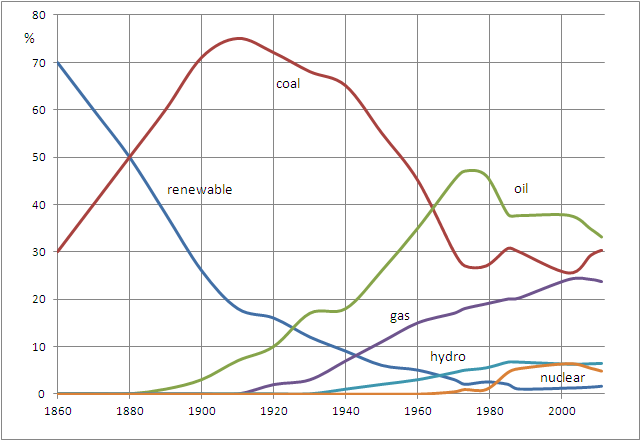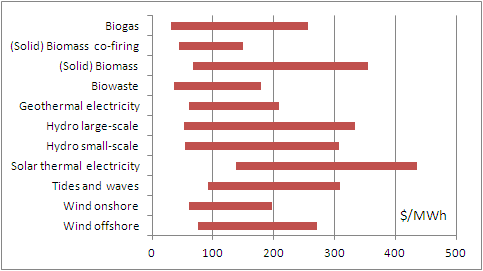Energy sectors
This session introduces the main characteristics of the different energy systems, i.e. how energy can be used:
- Oil
- Natural gas
- Coal
- Synthetic hydrocarbons
- Nuclear
- Electricity
- Renewable energy
Each of these sectors could warrant in-depth consideration. With a view to the objectives of this course, a very brief presentation is made.
It is recommended that you quickly read at least once Chapter 2 of the book Introduction to Global Energy Issues, which, although already very concise, provides more details.
By the end of the session, you are provided references to pages of the Thermoptim-UNIT portal for you to work your way through these brief explanations.
To follow the presentation, go to the next step
(Session realized on 05/18/13 by May and Renaud Gicquel)Different forms of energy

Two major categories
- non-renewable energies
- fossil fuels
- nuclear fission
- renewable energies
- geothermal
- solar
- wind, hydro, and tidal
- energy of draft animals
Oil
- advantages
- liquid form
- high capacity energy density
- relatively low environmental impact
- main technical constraints
- capital-intensive exploration/production
- necessary to refine crude
- decentralized distribution of petroleum products
Refining

Natural gas
- advantages
- clean
- high-energy content
- main technical constraints
- capital-intensive exploration/production
- extremely volatile
- distribution requires a network
- high rigidity
Coal
- main technical characteristics
- influence of labor and transportation
- pollution
- mostly limited to the production of electricity
- prospects
- large reserves
-
research on clean coal
- gasification
- liquefaction
Nuclear energy
- advantages
- high energy density
- absence of greenhouse gas emissions
- largely immune to geopolitical tensions
- risks
- hazards of uranium
- radioactivity of the fuel and fission products
- proliferation of nuclear weapons
Electricity production
- numerous technical solutions
- chemical energy (batteries, fuel cells)
- coal or uranium (steam power plants)
- gas or oil (steam power plants, gas turbines, combined cycles, diesel)
- renewable energy (hydro, wind, photovoltaic, solar thermodynamic conversion)
Electricity production
- specific uses
- lighting
- powering electric motors
- electrolysis
- induction heating
- main technical characteristics
- must be distributed to the places of consumption
- almost non-storable
- centralized and rigid industry
Fuels for transportation
World distribution of fuels for transport in 2009

Non-conventional fuels
- wide variety
- oil produced from heavy oil and oil shale
- biofuels, whether first or second generation
- synfuels
- liquid fuels from natural gas
- characteristics
- just emerging technologies
- may pose some serious pollution problems
Renewable energy
- five major categories
- geothermal energy
- direct solar energy (thermal and photovoltaic)
- indirect solar energy (wind, hydro, biomass)
- energy of the sea
- energy from draft animals (developing countries)
Renewable energy
- technical constraints
- relatively low available power density
- high variability of the source
- necessity to store
- economic constraints
- high capital cost
- necessity for a back-up
Two salient points
- diversity
- multiplicity of energy technologies
- very different national energy mixes
- rigidity
- complexity of energy systems
- concentration of commercial energy productive sectors
- high investment costs of generation, transmission and distribution
- long delays in implementation of energy projects
Time of implementation

Retrospective of main energy sources shares

Social acceptance
- concern about the possible consequences
- nuclear power plants
- wind farms
- dams
- high voltage power lines
- LNG terminals
- shale gas production facilities
- Not In My BackYard (NIMBY)
- Build Absolutely Nothing Anywhere Near Anything (BANANA)
Economic comparisons
- methodological difficulties
- different investment and operating costs
- cost-benefit analysis of the duration of the projects
- assumptions about the appropriate discount rate
-
take into account the external costs or costs of externalities
- public health
- effects of global warming
Cost of electricity from renewable sources

Production costs of different hydrocarbons

Energy sectors
This session showed that energy systems are very diverse, but almost all are rigid in terms of the investment required and implementation time.
Energy choices therefore affect the future in the medium and long term.
Each of these sectors could warrant in-depth consideration. With a view to the objectives of this course, only a very brief presentation was made.
The Technologies /Sectors section of the Thermoptim-UNIT portal allows you to work your way through these brief explanations.
Although sessions GEI7 Environmental issues and GEI8 Changing technology directly follow this session, they use a variety of concepts presented in the session GEI2 Economic and energy indicators that you should study now.